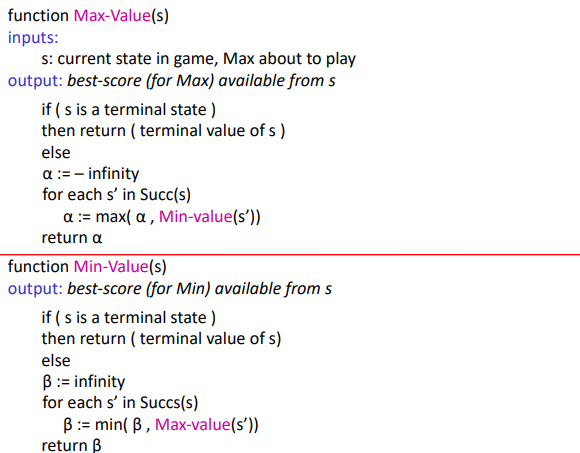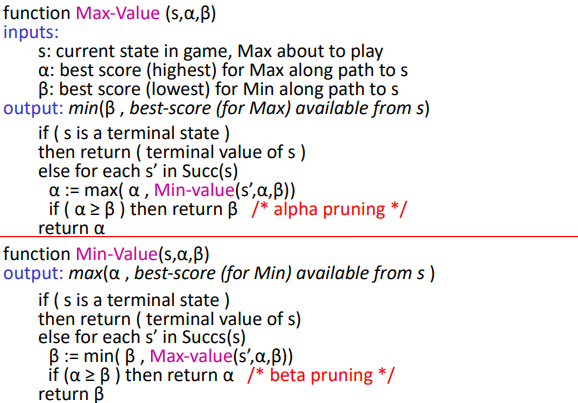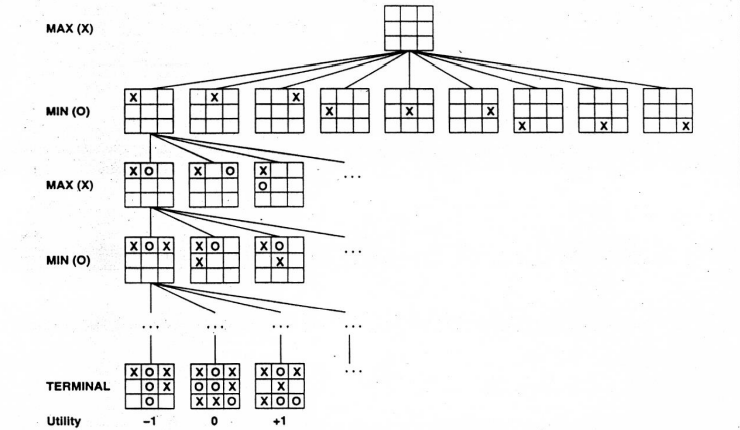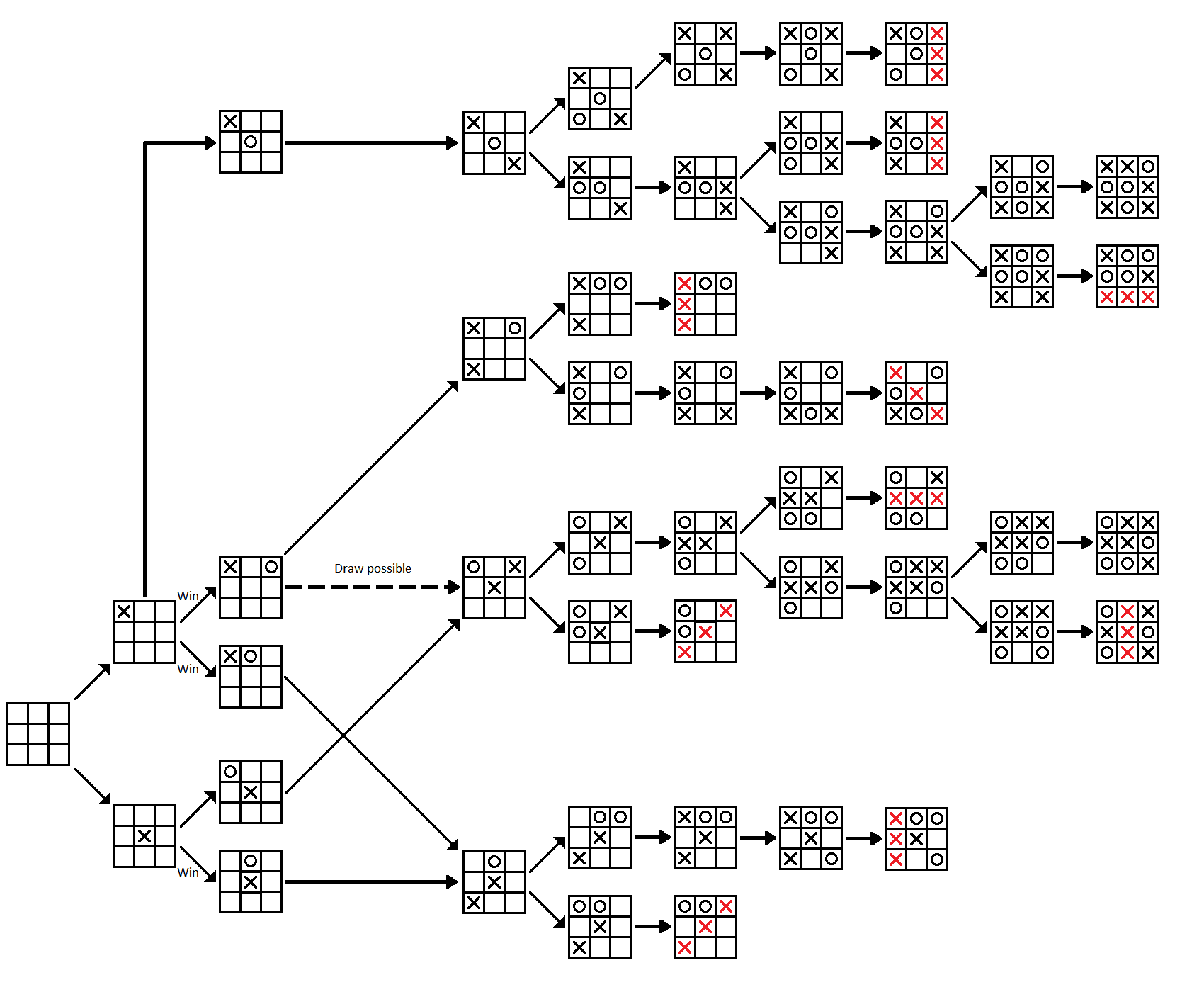Prev: W11, Next: W12 , Practice Questions: M27 M28 M29 M30 , Links: Canvas, Piazza, Zoom, TopHat (744662)
Tools
📗 Calculator:
📗 Canvas:
pen
📗 You can expand all TopHat Quizzes and Discussions: , and print the notes: , or download all text areas as text file: .
# Adversarial Search
📗 The search problem for games (one or more opponents are searching at the same time) is adversarial search: Link, Wikipedia.
➩ The initial state is the beginning of the game.
➩ Each successor represent an action or a move in the game.
➩ The goal states are called terminal states, the search problem tries to find the terminal state with the lowest cost (highest reward).
📗 The opponents search at the same time and tries to minimize their costs (or maximize their rewards).
➩ For zero-sum games, the sum of the rewards and costs for the two players is 0 at every terminal state. The opponent minimizes the reward (or maximizes the cost) of the first agent: Wikipedia.
TopHat Discussion
📗 [1 points] pirate got gold coins. Each pirate takes a turn to propose how to divide the coins, and all pirates who are still alive will vote whether to (1) accept the proposal or (2) reject the proposal, kill the pirate who is making the proposal, and continue to the next round. Use strict majority rule for the vote, and use the assumption that if a pirate is indifferent, they will vote reject with probability 50 percent. How will the first pirate propose? Enter a vector of length , all integers, sum up to .
📗 Answer (comma separated vector): .
TopHat Discussion
📗 [1 points] Two players, A and B, objects, each player can pick 1 or 2 each time. Pick the last object to win. If you pick first, how many should you pick?
📗 In the diagram, the node has the player name (or G for end of game) and the subscript means how many objects are left. The terminal nodes where player A wins are marked green, and where player B wins are marked blue.
📗 Answer: .
# Minimax Algorithm
➩ The game is solved backward starting from the terminal states.
➩ Each agent (player) chooses the best action given the optimal actions of all players in the subtrees (subgames).
📗 For zero-sum games, the optimal value at an internal state for the MAX player is called \(\alpha\left(s\right)\) and for the MIN player is called \(\beta\left(s\right)\).
📗 The time and space complexity is the same as DFS with \(D = d\).
TopHat Discussion
📗 [4 points] Highlight the solution of the game (drag from one node to another to highlight the edge connecting them).
Algorithm

# Non-Determinstic Games
📗 For non-deterministic games, some internal states represent moves by Chance (can be viewed as another player), for example, dice roll or coin flip. For those states, expected cost or reward are used instead of max or min.
📗 DFS on games with Chance is called expectiminimax: Wikipedia.
TopHat Quiz
(Past Exam Question) ID:📗 [4 points] Consider a zero-sum sequential move game with Chance. player moves first, then Chance, then . The values of the terminal states are shown in the diagram (they are the values for the Max player). What is the (expected) value of the game (for the Max player)?
📗 Note: in case the diagram is not clear, the probabilities from left to right is: , and the rewards are .
📗 Answer: .
# Pruning
📗 When a branch will not lead the current agent (player) to win, the branch can be pruned (both players will not need to search the subtree). DFS with pruning is called Alpha-Beta Pruning: Wikipedia.
➩ During DFS, keep track of both \(\alpha\left(s\right)\) and \(\beta\left(s\right)\) for each state.
➩ Here, the \(\alpha\left(s\right)\) and \(\beta\left(s\right)\) values are the current best value of an internal state so far (based only on the successor states that are expanded), which are not necessarily the final optimal values.
➩ Prune the subtree after \(s\) if \(\alpha\left(s\right) \geq \beta\left(s\right)\).
TopHat Discussion
📗 [4 points] Highlight the nodes that will be alpha-beta pruned in the following game.
Algorithm

# Rationalizability
📗 Unlike sequential games, for simultaneous move games, one player (agent) does not know the action taken by the other player.
📗 Given the actions of the other players, the optimal action is called the best response.
📗 An action is dominated if it is worse than another action given all actions of the other players.
➩ For finite games (finite number players and finite number of actions), an action is dominated if and only if it is never a best response.
➩ An action is strictly dominated if it is strictly worse than another action given all actions of the other players. A dominated action is weakly dominated if it is not strictly dominated.
📗 Rationalizability (IESDS, Iterative Elimination of Strictly Dominated Strategies): iteratively remove the actions are that dominated (or never best responses for finite games): Wikipedia.
TopHat Discussion
📗 [1 points] Write down an integer between and that is the closest to two thirds \(\dfrac{2}{3}\) of the average of everyone's (including yours) integers.
📗 Answer: .
TopHat Quiz
(Past Exam Question) ID:📗 [4 points] Perform iterated elimination of strictly dominated strategies (i.e. find rationalizable actions). Player A's strategies are the rows. The two numbers are (A, B)'s payoffs, respectively. Recall each player wants to maximize their own payoff. Enter the payoff pair that survives the process. If there are more than one rationalizable action, enter the pair that leads to the largest payoff for player A.
| A \ B | I | II | III |
| I | |||
| II | |||
| III | |||
| IV |
📗 Answer (comma separated vector): .
# Nash Equilibrium
📗 Another solution concept of a simultaneous move game is called a Nash equilibrium: if the actions are mutual best responses, the actions form a Nash equilibrium: Wikipedia.
TopHat Quiz
(Past Exam Question) ID:📗 [4 points] What is the row player's value in a Nash equilibrium of the following zero-sum normal form game? A (row) is the max player, B (col) is the min player.
| A \ B | I | II | III | IV |
| I | ||||
| II | ||||
| III | ||||
| IV |
📗 Answer: .
# Prisoner's Dilemma
📗 A symmetric simultaneous move game is a prisoner's dilemma game if the Nash equilibrium (using strictly dominant actions) is strictly worse for all players than another outcome: Link, Wikipedia.
➩ For two players, the game can be represented by a game matrix: \(\begin{bmatrix} - & C & D \\ C & \left(x, x\right) & \left(0, y\right) \\ D & \left(y, 0\right) & \left(1, 1\right) \end{bmatrix}\), where C stands for Cooperate (or Deny) and D stands for Defect (or Confess), and \(y > x > 1\). Here, \(\left(D, D\right)\) is the only Nash equilibrium (using strictly dominant actions) but \(\left(C, C\right)\) is strictly preferred by both players.
Example
# Static Evaluation Function
📗 The heuristic to estimate the value at an internal state for games is called a static (board) evaluation (SBE) function: Wikipedia.
➩ For zero-sum games, SBE for one player should be the negative of the SBE for the other player.
➩ At terminal states, the SBE should agree with the cost or reward at that state.
📗 For Chess, the SBE can be computed by a neural network based some features such as: material, mobility, king safety, center control; or a convolutional neural network treating the board as an image.
📗 IDS can be used with SBE.
➩ In iteration \(d\), the depth is limited to \(d\) and the SBE of the internal states at depth \(d\) are used as their cost or reward.
TopHat Discussion
📗 [4 points] The subscripts are heuristics (static evaluation, or estimated alpha and beta values) at the internal nodes.
TopHat Discussion
Name:📗 [1 points] Find the optimal strategy against a min player that uses a random strategy with probability \(p\):
Probability \(p\): 1
Heuristic: 0
Winner: -
1 slider 0
# Monte Carlo Tree Search
📗 Random subgames can be simulated by selecting random moves for both players: Wikipedia.
📗 The move corresponding to the highest expected reward (win rates) can be picked.
➩ The move corresponding to the highest optimistic estimate of the reward (win rates) can be also picked.
Example
📗 Alpha GO uses Monte Carlo Tree Search with more than \(10^{5}\) play-outs: Wikipedia.
Math Notes
📗 The optimistic estimate of the reward is called upper confidence bound of the rewards (or win rates here): \(\dfrac{w_{s}}{n_{s}} + c \sqrt{\dfrac{\log T}{n_{s}}}\), where \(w\) is the number of wins after state \(s\), \(n\) is the number of simulations after \(s\), and \(T\) is the total number of simulations.
➩ More details will be discussed in the reinforcement learning lectures.
test prt,nim,mnx,chn,abp,tt,ie,zs,abs,tee q
📗 Notes and code adapted from the course taught by Professors Jerry Zhu, Yingyu Liang, and Charles Dyer.
📗 Please use Ctrl+F5 or Shift+F5 or Shift+Command+R or Incognito mode or Private Browsing to refresh the cached JavaScript.
📗 If you missed the TopHat quiz questions, please submit the form: Form.
📗 Anonymous feedback can be submitted to: Form.
Prev: W11, Next: W12
Last Updated: November 21, 2025 at 11:41 PM

